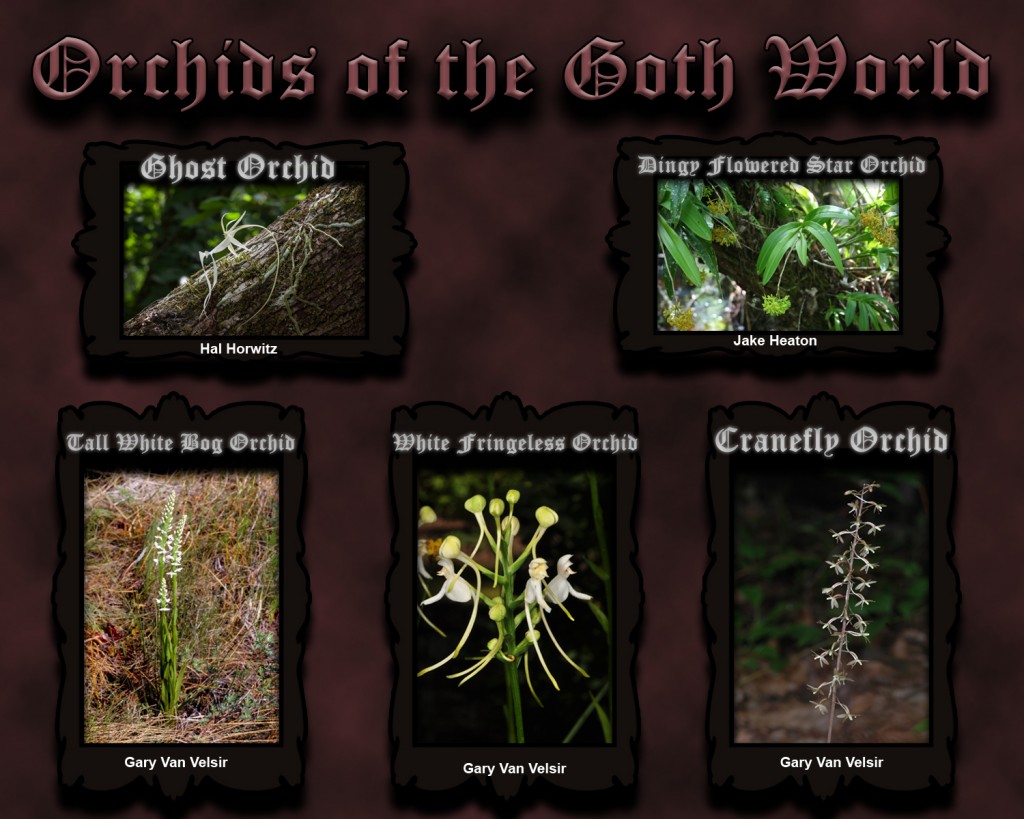by Heather Soulen
Have you ever been at a stop light and seen a butterfly sampling nectar from flowers in small container garden? Maybe you’ve seen bees darting flower to flower as you tend your garden. Or maybe, as you walk the city streets, you see other insects whizzing about the flowering weeds that struggle to survive in the cracks of our concrete jungle. Based on these experiences, you might think that flowers only get pollinated during the day. Here’s a secret, and it’s a dark, gothic secret: Pollination also occurs under the veil of night. Some plants, like orchids and their pollinators, live a life less ordinary.
The majority of North American orchids are pollinated during the daytime. But there are a few special orchids that are part of the pollination graveyard shift. In North America, the rare Ghost Orchid, Cranefly Orchid, Tall White Bog Orchid, Dingy Flowered Star Orchid and most of the orchids in the genus Platanthera are special orchids that are pollinated at night.
Watch: First sighting of night-time pollination of the elusive Ghost Orchid
To find orchids, nocturnal pollinators tap into their spidey-senses. Foremost is the smell of sweet, sweet nectar – pure ambrosia of the moth gods! The Giant Sphinx Moth hones in on the Ghost Orchid’s scent, a tantalizing perfume of crisp apples that is strong in the hours before dawn. Armyworm moths, Porcelain Gray moths and Red Twin Spot moths are captivated by the Cranefly Orchid’s faint yet sweet fragrance that dances through the night air.
Orchids in the genus Platanthera (the Bog Orchids) are often pollinated by moths, but bees, beetles and mosquitoes are also known to stop by the club. The gothiest of the goth moths, such as Alfalfa Looper moths and Cutworm moths, are drawn to the Tall White Bog Orchid by its strong, spicy scent of cloves. (Let’s be honest, you can’t get much more goth than cloves). The flowers of the Flat Spurred Piperia also have a spicy, clove scent that dances like a goth on nighttime air currents, summoning other goth moths (Family: Geometridae) to the club. The Eastern Prairie Fringed Orchid entices the Hermit Sphinx moth and Hawkmoths with a similar aroma. Chaparral Orchids have a heavenly honey scent, while the White Fringeless Orchid has a coquettish sweet fragrance that lures its nocturnal insect pollinators with an aroma that is said to intensify around 7pm and slowly dissipate after 11pm like an ethereal spirit that never was.
Some moths favor savory over sweet. The Dingy Flowered Star Orchid produces an evocative and intoxicating fragrance of overly-ripe vegetables. This earthy scent is most intense between late afternoon and dawn, and male night moths like Little Carol’s Wasp Moth, Edwards’ Wasp Moth, Yellow-collared Scape Moth and Spurge Spanworm Moth can’t get enough. Mmmmmm…delish!
So the next time you find yourself alone and outside walking through the woods at night, dial up your spidey-sense to 11. Let the nighttime air surround you and dance over your skin. Drink in the nocturnal aromas, and see if you can catch the faint scent of orchids wafting on the dark of night.
Watch: The endangered Ghost Orchid has only one pollinator, the Giant Sphinx Moth. Until now, no one had ever seen the pollination occur. Used with permission of Chris Little.
Love orchids? Check out the North American Orchid Conservation Center (NAOCC), where scientists at the Smithsonian and other organizations across the country are fighting to conserve North America’s 200-plus native orchids. Find out more about the ones near you at Go Orchids, a friendly guide to the orchids of North America. Because orchids are canaries in the coal mine for extinction, saving orchids can save ecosystems.


